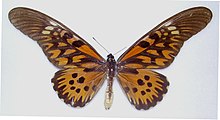Loading AI tools
Species of butterfly From Wikipedia, the free encyclopedia
Papilio antimachus, the African giant swallowtail, is a butterfly in the family Papilionidae. With a wingspan between 18 and 23 centimetres (7.1 and 9.1 in), it is the largest butterfly in Africa and among the largest butterflies in the world. The shape of the wings differ between the males and females.
| African giant swallowtail | |
|---|---|
 | |
| Male, upperside | |
| Scientific classification | |
| Domain: | Eukaryota |
| Kingdom: | Animalia |
| Phylum: | Arthropoda |
| Class: | Insecta |
| Order: | Lepidoptera |
| Family: | Papilionidae |
| Genus: | Papilio |
| Species: | P. antimachus |
| Binomial name | |
| Papilio antimachus | |
| Synonyms | |
| |
The wings are long and narrow and the ground colour is orange brown with black markings. P. antimachus live in the tropical rainforests of west and central Africa. The distribution area (range) stretches from Angola, Cameroon, Democratic Republic of the Congo, Republic of the Congo, Gabon, Ghana, Ivory Coast, Liberia, Nigeria, Sierra Leone, and Uganda. It is much rarer in the west of its range (Guinea to Cameroon) than in the eastern parts of its range. It probably stays in forest canopy but males come down to mud-puddle. The male is larger than the female and can be seen in groups at nectar. The females show themselves less, continually flying high above the treetops. It has been seen hill-topping in Liberia.[3] The butterfly may have no natural enemies because it is very toxic and advertises it with a resemblance of other similar butterflies including the much smaller Acraea. The larval foodplant is unknown and nothing is published on the early stages (egg, larva, pupa). Cardiac glycosides found in the Imago by Miriam Rothschild[4] indicate that the so-far unidentified larva, most probably, sequesters foodplant toxins which persist through pupation into the imago as an aposematic protection against predation, and therefore that the larval foodplant is probably an asclepiad vine.
The type specimen was probably collected by Henry Smeathman from whose collections it was described by Dru Drury. The specimens were later bought by Alexander Macleay (1767–1848).[5]
Seamless Wikipedia browsing. On steroids.
Every time you click a link to Wikipedia, Wiktionary or Wikiquote in your browser's search results, it will show the modern Wikiwand interface.
Wikiwand extension is a five stars, simple, with minimum permission required to keep your browsing private, safe and transparent.